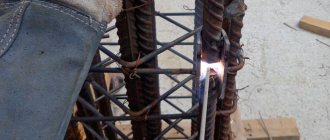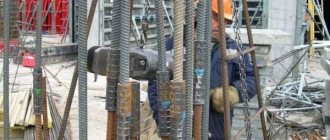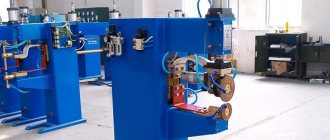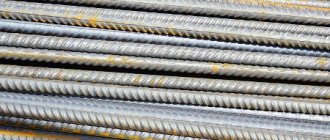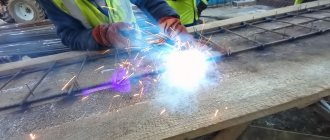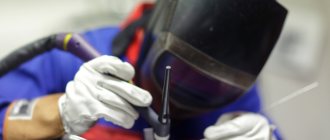All construction processes have state standards that determine how they should be carried out. The standards clearly indicate what materials should be used, what technologies and the sequence of operations performed. Welding of reinforcement is no exception.
How two reinforcement rods are connected by hot welding
For this construction process, a GOST was developed called “Joints of welded reinforcement and embedded products of reinforced concrete structures.” The standard was introduced on July 1, 1992 under the number 14098-91. It contains two tables that define the requirements for bath welding of reinforcement, the topic of which is in the article.
- In the table, number “1,” the types of reinforcement welding are indicated: butt, cross, tee and lap. The butt category includes welding using a bath or in another way: inverter form. That is, in this way you can weld reinforcing bars installed end-to-end.
- Table No. 30, called “Terms and Explanations,” gives the concept of reinforcement welding using the pool method. The table says that pool welding is a process in which the melting of the joined rods occurs mainly due to the heat of the molten metal pool.
Notice the word - mostly - which suggests that it's not just the molten metal that melts the reinforcing bars. Therefore, we will thoroughly understand the technology of welding reinforcement using the bath method.
The final result of pool welding
a brief description of
Bath welding is a method of welding metal products that uses a U-shaped fixture. It has several names - trays or bracket plates for welding reinforcement. This formed the basis for the name of this welding method. Parts of the reinforcement are immersed in the bracket-tub, molten steel fills it to the brim. After this, the metal hardens and forms a seam with high strength.
To prevent molten steel from flowing out from the ends of the bath, restrictive elements are placed. And at the end of the welding process, the pools are combined with reinforcement and molten steel. There are removable linings that are made of copper, its alloys, ceramics, and graphite. These options are intended for repeated use.
Bath welding of reinforcement can be carried out using one or more electrodes. This welding method allows you to weld metal elements in any position in space, except for the ceiling. The size of the lining must be larger than the diameter parameters of the reinforcement. There should be at least 15 mm from the edges of the bath to the element being welded.
If the products are in a horizontal position, then to create a bath, a steel plate is welded to the connecting reinforcing bars in the area of their junction. When welding rods that are in a vertical position, stamped steel forms are used. They are welded to the end area of the product, which is located below.
Single-electrode method algorithm
To carry out work on fastening various products from A500C reinforcement, the best way is welding using copper plates. This weld pool is made without grooves to hold the metal, but the inside is made with a smooth surface, which makes it easy to dock the reinforcement.
The method is used when installing structures exposed to static and vibration loads. Welding machines can be used with direct and alternating current power; the main thing is that they must be of sufficient power and performance.
Bath welding begins from one of the sides, gradually moving towards the center. The electrode should advance slowly, making circular or crescent movements. This method will ensure uniform filling of the bath cavity and heating of the base metal.
When melting, the electrode is lowered, ensuring the formation of the shortest arc. The metal rises to the top edge of the bath, completely covering the fittings. After this, the welding bath is considered completed. When the seam has cooled, you can adjust the parts.
When stopping welding, be sure to knock off the slag and light an arc at the finished edge of the seam. This will make it possible to reliably cover the place where the seam stops and is interrupted. The seam should be completed in the middle of the bath to prevent holes and voids. Such places need to be cleaned of slag and boiled again.
Features and nuances of the welding process
Welding reinforcement using the hot tub method has several additional features that must be considered before starting work. This technology is considered a simple process, but still, if you want to get a high-quality and durable connection, you should prepare carefully.
Bath welding has the following features:
- The welding process must be carried out continuously. This makes a huge difference in achieving an even melt. The fact is that the temperature indicators of some types of metals are quite high; it takes a lot of time to warm up. Due to the fact that welding work is carried out in a continuous mode, the steel melts much faster.
- Bubbles of slag and protective gas form on the surface of the metal product. To let them out, you need to make a hole in the bath. But still, slag formations are not considered foreign components; they protect the seams from oxidation.
- The technology of bath welding of reinforcement involves the appearance of a protective crust on the joint surface. Usually its formation indicates compliance with all the rules of the welding process.
- Immediately after welding is completed, there is no need to peel off the protective crust; you need to wait until the molten metal hardens. In the meantime, while the part is hot, you can lightly tap it on all sides, this will eliminate the increased stress.
- When welding, the electrode should not be held motionless at the joint area. Beginners think that this will ensure that thermal energy can independently disperse over the surface of the product and the steel will melt evenly. During the process, the movements must be consistent, and at the same time the welder must capture unmelted edges.
- The workflow speed should not be too slow or too fast.
- If the welder does everything too quickly during welding, he will not be able to melt the metal to the required temperature, and the joint itself will be of poor quality.
- If the welder is slow, he will not melt the steel evenly. As a result, it will be distributed in the bath so that the finished seam will turn out to be of poor quality. The optimal welding speed is indicated in GOST standards.
Welding with a comb and several electrodes
This method is called multi-electrode welding, which uses a special holder called a comb. Several electrodes (3-5 pieces) are inserted into it at once. The principle of melting the reinforcement here is exactly the same as in the case of one consumable. But it also has its own characteristics.
- The arc of electrodes is ignited not on the fittings, but on a metal tray, often on its bottom. You just can’t ignite several electrodes at once on one end.
- To strengthen the joint, the electrodes are periodically dipped into the molten metal to warm it up.
- You can not leave a gap between the reinforcement bars, pressing them tightly against each other.
- When the fittings are positioned vertically, do not strongly deviate the electrodes from perpendicular to the connection axis.
This method is rarely used when connecting reinforcement inside concrete structures. It is not easy, and not all welders know it. It is better to use split molds made of copper or graphite for this, which increases the cost of the process.
Single- and multi-electrode pool welding
Advantages
Pool welding is a simple and easy method of connecting sections of metal structures. This technology is used in many areas of production; it allows you to work with different types of metal.
Bath welding of reinforcement and columns has a number of advantages:
- this method can be used for fixed parts of metal structures. There is no need to rotate and move them to create a strong connection over the entire surface;
- during the melt, uniform rather than spot heating of the rods occurs;
- examination of the seam can be performed using available methods, for example, using gamma-ray diagnostics;
- Conventional equipment can be used for the work process;
- welding using this method allows you to obtain a strong and high-quality connection;
- baths for welding reinforcement prevent the spreading of molten material, they form a neat and even seam;
- minimal costs for consumables;
- maximum convenience that facilitates welding. And the steel form serves as an additional stiffening rib;
- You can quite simply select the shapes to match the dimensions of the rod. They are available in a wide range.
Advantages and disadvantages of tub welding of reinforcement
The advantages include:
- rational consumption of raw materials;
- high quality connection;
- sophisticated technology that allows you to achieve high quality;
- a variety of inverter shapes, which allows you to make a choice exactly according to the dimensions of the fittings.
Negative aspects of technology:
- more demanding preparation that takes a lot of time, especially with regard to the precise alignment of the ends of the two reinforcing bars being connected;
- high consumption of steel baths;
- high price of copper molds.
So, this method of connecting reinforcing bars, if carried out correctly, results in a high quality final result. The seam is strong and reliable. The joint is flexible, like solid reinforcement, which allows it to withstand bending loads.
Flaws
But it is still worth remembering that welding reinforcement using the hot tub method is not just an easy method of obtaining a strong connection; this process has some disadvantages that should be taken into account when carrying out welding work.
Among the negative aspects are:
- When carrying out the welding process, continuity of work must be observed;
- you need to ensure that the heating covers the entire contact area;
- This welding method requires professional training;
- usually welding pools are used only once, they are not intended for repeated use;
- The preparatory stage must be followed, and this is an additional time investment.
Important! If the required temperature conditions are not observed during the welding process. If cooled too quickly, too much slag may form.
State standards
For this construction process, a GOST was developed called “Joints of welded reinforcement and embedded products of reinforced concrete structures.” The standard was introduced on July 1, 1992 under the number 14098-91.
Bath welding is a reliable and commonly used method. A distinctive feature of this process from all other types of welding is its continuity, which is very important for uniform melting. Thanks to this process, the metal melts much faster.
The welding method is used in the construction of various massive structures and buildings. The seam created using this welding is capable of withstanding moving loads without destroying the integrity of the structure and meets the requirements of GOST. If conventional butt welding is carried out, it can lead to failure of the joint near the seam, thus significantly degrading the quality of the weld.
Equipment used
We have looked at what it is - hot tub welding, but you still need to know what equipment should be used during this process. This is an important condition on which the quality and strength of the welded joint depends.
Typically, the following elements are used during bath welding:
- Welding machine. This element reduces the voltage to 220 volts and produces direct current with great strength. It is called a welding inverter; it has a full range of functions and modes. Currently, small-sized devices are being produced that can be used at home.
- Overlay brackets for welding reinforcement. These products should be selected in accordance with the type of connection and the nature of the elements being welded. For horizontal ones, it is recommended to use options such as C14-Mn, C15-Pc, C16-Mo.
- To protect the molten metal in the weld pool, in some situations it may be necessary to create an environment of inert gas; this is usually required by the quality of the materials being welded. For these purposes, it is recommended to use small cylinders with inert gas, which are commercially available.
- Consumable type electrodes. They can have different coatings made of aluminum, copper, steel and other alloys. For ordinary work, rods of the MP-3 or ANO brands are suitable; their diameter should be within 2-4 mm. These consumables can always be found on sale. But only SSSI rods are suitable for critical equipment.
- Welder protective mask. The most suitable option for welding work would be a product that is mounted on the head. Additionally, you need clothing and gloves made of protective material. Products must be protected from ultraviolet rays and splashes of molten metal.
Welding mode
Bath technology for joining reinforcement is most often used for joining large diameter rods. Therefore, the welding mode is one of the important criteria for achieving high quality joints. The mode includes: electrode diameter, current strength, and all this depends on the diameter of the reinforcing bars being welded. The dependency here is:
| Diameter of fittings, mm | Electrode diameter, mm | Current strength, A |
| 20-25 | 5 | 230-260 |
| 36, 45 | 6 | 300-330 |
| 60 | 7 | 420 |
| 70 | 8 | 500 |
Since welding of this type involves the use of high currents, an important component of the process is safety precautions. It is important before starting to connect the reinforcement using bath welding to make sure that the equipment, tools and fixtures used are in technically sound condition. Much attention should be paid to grounding, special clothing and a welding helmet. Welding sites must be equipped with primary fire extinguishing equipment.
How is bath welding carried out?
The technology for bath welding of reinforcement and columns consists of several stages. During the first step, all materials and parts to be welded are prepared. And in the next stage, the main welding work is carried out.
There are a few things you should do when preparing:
- Cleaning the ends of the reinforcing bars with a wire brush until shiny. During this stage, it is worth removing all areas with rust, dirt, paint and other types of contaminants. All this can deteriorate the quality of the connection, making it brittle and weak. The clearing size at each end should be at least 3 cm;
- an inverter mold must be spot welded to the lower planes of the joining rods. It will serve as a container for accumulating molten steel.
After this, you can begin welding the columns and fittings. The electrode needs to be brought to the end of one of the rods and begin to melt it. The consumable needs to be moved over the entire area of the end - movements can be circular or from side to side. Afterwards you can move to the opposite end of the reinforcement being welded. Actions should be carried out one at a time until the bath is completely filled with molten metal.
It is worth noting! All actions and movements during the welding process should be light, because melting occurs at high currents. For example, if electrodes with a diameter of 7-8 mm are used, then a current of 400-450 amperes should be applied to them.
Welding must continue until the molten metal covers the rods being connected. After this, it is recommended to carry out the final steps correctly - you need to once again evenly heat the metal in the weld pool, this is necessary for its uniform cooling. Next, the electrode is rotated between the ends of the reinforcement being connected, but this should not be done too much.
Bath welding process is a popular method that is used in various industries. It allows you to get a strong, high-quality and even connection, and this is achieved through the use of pad brackets for bath welding, also these elements are called baths. They also prevent splashing and flow of molten material from the welding zone. But still, before carrying out work, it is worth considering its important features and principles.
The essence of the process
The pool welding method is most often used to connect rods with a large cross-section of 20 - 100 mm. This range of sizes is most suitable for making high-quality seams.
When connecting, the bath completely compresses the contact area. In this case, a gap of 2 mm must be left between the parts being connected to allow the metal to flow in and fill all the pores.
When carrying out welding work, in accordance with GOST and SNiP requirements, a reliable joint is obtained while maintaining characteristics along the entire length of the assembled structure.
Shifts of the workpieces are limited by a bath placed at the joint. Thread baths are used to connect critical joints, but this method requires cutting threads at the ends of the rods.
The part for installation is selected taking into account the small gap between the workpiece and the wall of the product. The electrode metal flows into it, forming an interatomic connection of the base metal with the electrode rod.
The sides at the edges of the bath do not allow metal to flow out, while the slag is squeezed out to the top of the seam. The vertical rods are connected in the same way when making columns.

